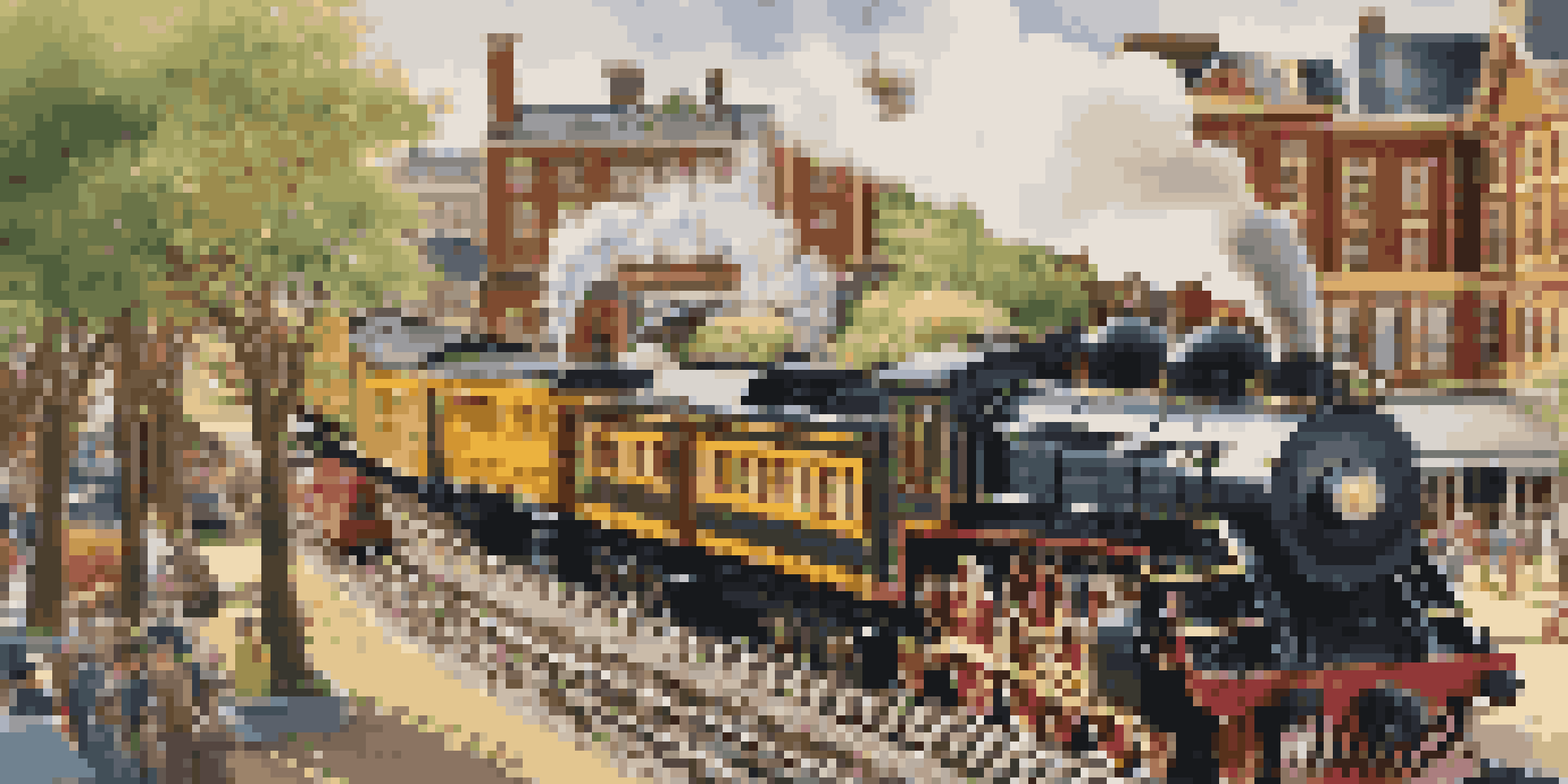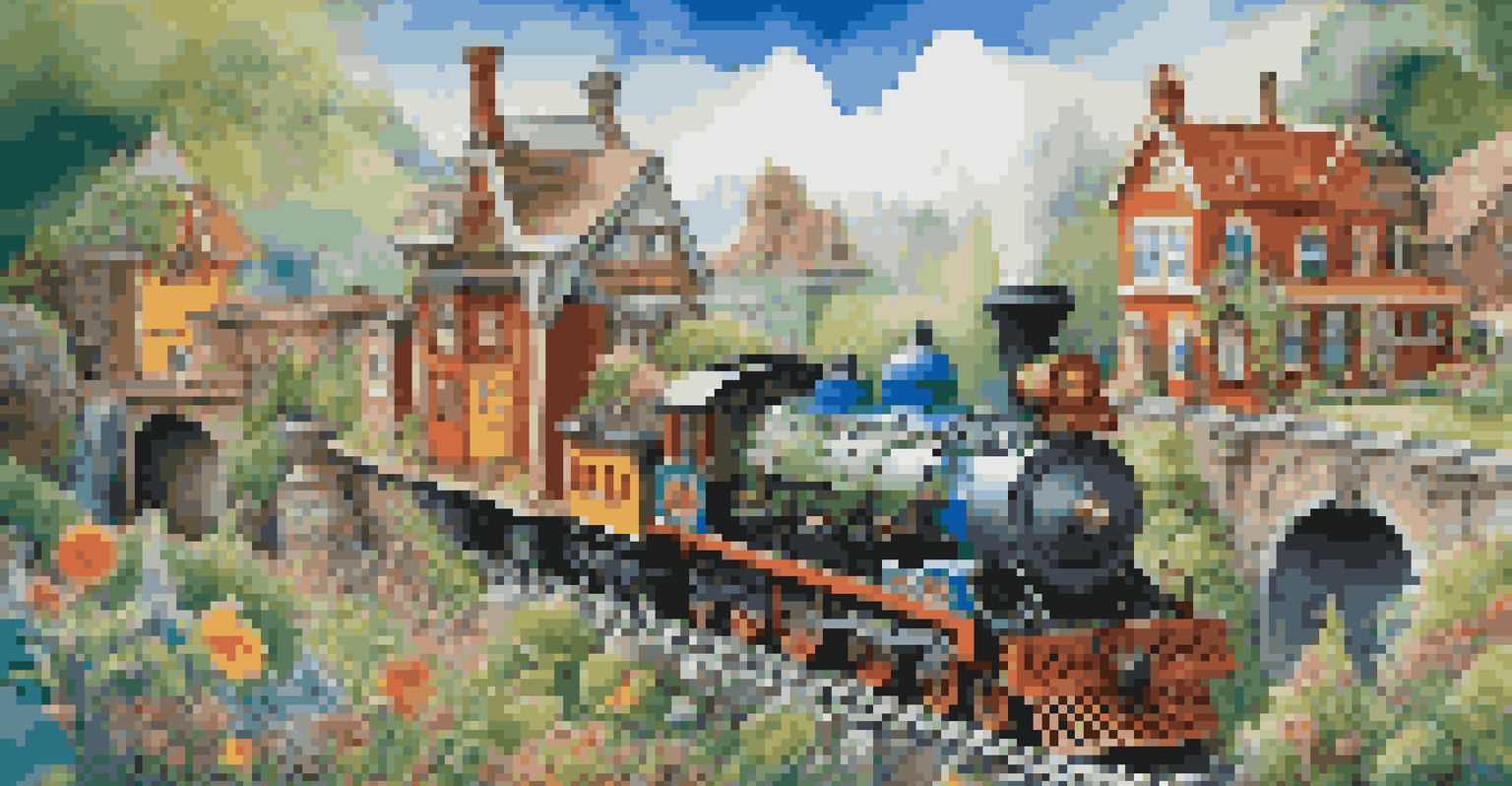The Evolution of Model Railroads: Trends Over Time

The Origins of Model Railroading: A Historical Perspective
Model railroading has its roots in the early 19th century, when small-scale models were created to simulate real trains. These early versions were often handcrafted by enthusiasts, focusing on craftsmanship rather than mass production. As trains became a symbol of progress and innovation, the hobby of model railroading began to attract more followers, leading to the creation of dedicated clubs and societies.
The joy of modeling is not just in the finished product, but in the journey of creating it.
The first commercially available model trains appeared in the 1890s, primarily as toys for children. However, they quickly gained popularity among adults who appreciated the intricate details and engineering challenges involved in building and operating model railroads. This period marked the beginning of a passionate community that would grow over the decades, nurturing creativity and technical skills.
By the early 20th century, advancements in technology allowed for more elaborate layouts, with electric trains replacing their steam-powered counterparts. This shift not only made model railroading more accessible but also sparked a wave of interest that would continue to evolve through the century.
The Golden Age: Model Railroads in the Mid-20th Century
The mid-20th century is often regarded as the golden age of model railroading, characterized by rapid innovation and an explosion of interest. This period saw the introduction of new materials, such as plastic, which made model building easier and more affordable. As a result, hobbyists could create more intricate and realistic layouts without breaking the bank.

During this time, manufacturers began producing a wider variety of train models, allowing enthusiasts to recreate specific railroads and eras. From classic steam locomotives to modern freight trains, modelers had access to a diverse range of options. This diversity not only fueled the hobby but also sparked friendly competition among modelers to create the most authentic setups.
Model Railroading's Rich History
From its 19th-century origins to its golden age in the mid-20th century, model railroading has evolved significantly, attracting a passionate community of enthusiasts.
Clubs and exhibitions became increasingly popular, providing a platform for enthusiasts to showcase their work and share ideas. This sense of community fostered collaboration and camaraderie, making model railroading not just a hobby, but a shared passion that connected people across generations.
Technological Advancements: The Impact of Digitalization
The advent of digital technology in the late 20th century revolutionized model railroading. Digital Command Control (DCC) systems emerged, allowing hobbyists to control multiple trains independently on the same track. This advancement made layouts more dynamic and engaging, as operators could easily change speeds and directions without complicated wiring.
Model railroading is a hobby that can bring out the engineer, artist, and storyteller in anyone.
Additionally, computer software began to play a significant role in layout design and operation. Programs allowed enthusiasts to visualize their designs before committing to physical construction, making it easier to plan complex setups. This digital shift not only streamlined the building process but also opened the door for more ambitious projects.
As more hobbyists embraced technology, the community expanded to include online forums and social media groups. These platforms became vital for sharing tips, resources, and inspiration, creating a global network of model railroaders eager to connect and learn from one another.
Sustainable Practices: A Modern Approach to Model Railroading
In recent years, there has been a growing awareness of sustainability within the model railroading community. Many hobbyists are now prioritizing environmentally friendly practices, such as using recycled materials for building scenery and structures. This shift reflects a broader trend towards sustainability in hobbies and industries alike.
Additionally, manufacturers have started to produce more energy-efficient models, incorporating LED lighting and low-power motors. These innovations not only reduce energy consumption but also enhance the realism of models, as trains can operate quietly and smoothly. This commitment to sustainability resonates with many enthusiasts who value both their hobby and the planet.
Embracing Technology and Sustainability
Modern advancements like Digital Command Control and a focus on sustainable practices are transforming model railroading, making it more dynamic and environmentally friendly.
The incorporation of sustainable practices has also led to a renewed focus on landscaping and natural scenery. Modelers are increasingly interested in recreating realistic ecosystems, using native plants and environmentally friendly techniques to enhance their layouts. This trend not only beautifies model railroads but also raises awareness about ecological issues.
Diversity in Themes: Expanding the Story of Model Railroads
As the model railroading hobby has evolved, so too have the themes and stories that enthusiasts choose to explore. Gone are the days when layouts were primarily focused on traditional freight and passenger trains. Today, modelers are embracing a diverse array of themes, from historical reenactments to fantasy worlds.
This shift has allowed hobbyists to express their creativity in unique ways, incorporating elements of pop culture, personal interests, and even fictional narratives into their layouts. For example, some modelers create intricate setups based on beloved movies or books, merging storytelling with craftsmanship. This newfound diversity has made the hobby even more relatable and engaging for a broader audience.
Moreover, this trend has also encouraged collaboration across various creative fields. Artists, writers, and designers are increasingly drawn to model railroading, enriching the community with fresh perspectives and ideas. As a result, model railroads are evolving into vibrant canvases that reflect the individual passions and stories of their creators.
The Role of Community: Connecting Model Railroaders Worldwide
The sense of community has always been a cornerstone of model railroading, and that connection has only deepened with the rise of the internet. Online forums, social media groups, and virtual meetups have made it easier than ever for enthusiasts to connect, share, and learn from one another. This global network fosters collaboration and support, making the hobby more accessible for newcomers.
Local clubs and exhibitions continue to play a vital role in nurturing face-to-face connections. These gatherings provide opportunities for hobbyists to showcase their work, exchange ideas, and participate in workshops. The camaraderie found in these settings often leads to lasting friendships, as enthusiasts bond over their shared passion for trains and model building.
Diverse Themes and Community Growth
The hobby is expanding to include a wide range of themes, encouraging creativity and fostering a global community of model railroaders through online connections.
As the community continues to grow, it also embraces diversity and inclusion, welcoming individuals from all walks of life. This evolving landscape encourages unique perspectives and experiences, enriching the hobby and ensuring its future remains bright and vibrant.
Future Trends: What Lies Ahead for Model Railroading
Looking ahead, the future of model railroading seems promising, with technology and creativity continuing to reshape the hobby. Innovations such as 3D printing are becoming increasingly popular, allowing hobbyists to create custom train parts and scenery that were previously difficult or expensive to obtain. This accessibility empowers modelers to personalize their layouts like never before.
Furthermore, advancements in virtual reality (VR) and augmented reality (AR) may soon have a significant impact on how enthusiasts experience their trains. Imagine stepping into a virtual world where you can operate your model railroad from a first-person perspective or overlay digital elements onto your physical layout. These technologies hold the potential to transform the way we engage with model railroading.

As these trends unfold, the community will likely continue to adapt and evolve, fostering creativity and collaboration among hobbyists. With a rich history and a commitment to innovation, model railroads are sure to remain a cherished pastime for generations to come.